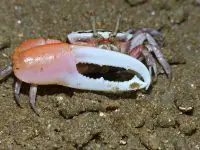Fiddler crabs (Uca) are small semi-terrestrial aquatic crabs. They belong to the genus Uca and there are 100 species of crabs under this genus. The closest relatives of these crabs are ghost crabs. They form groups of thousands. One of the claws (chelae) in male crabs is larger than the other and it is used in signaling and clashes. During feeding, the smaller chela moves up to the mouth just like “playing a fiddle” and hence, it explains its name.
It has a box-shaped body and smooth shell surface. In the middle of the carapace, the two long eyestalks are situated. Unlike female fiddler crabs, the male crab is brighter and it has a grayish-blue carapace along with dark spots. The chelae (claws) of female crabs are both equal in size. But the male crab has asymmetric claws.
The length of its carapace is 1 inch. The oversized claw in male crabs measures up to 2 inches in length.
They are short-lived crabs. In the wild, they have a lifespan of up to 2 years while in captivity, they can live for no more than 3 years.
In the wild, they have a lifespan of up to 2 years while in captivity, they can live for no more than 3 years.
For a female crab, the oversized claw and its wagging quality determines the mating partner. Besides, the more aggressive its display would be, the more healthy a male crab would appear and in turn, a female would most likely accept her mating partner.
Underneath its abdomen, a female crab glues thousands of eggs and release them in water.
They are distributed across the Indo-Pacific region as well as West Africa, East Pacific and West Atlantic.
They occupy small trees of mangroves in swamplands, lagoons and soft sandy shores. They live in burrows on the beaches that may be 3 feet in length.
Fiddler crabs are detritus feeders and they tend to sift through the contents of decaying animals and plants. In winter, they stay inside the burrows.
Other Name: Calling crab





